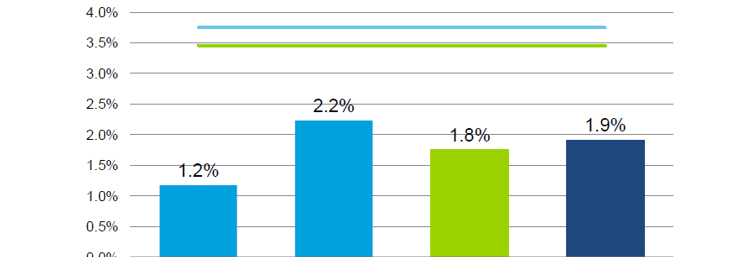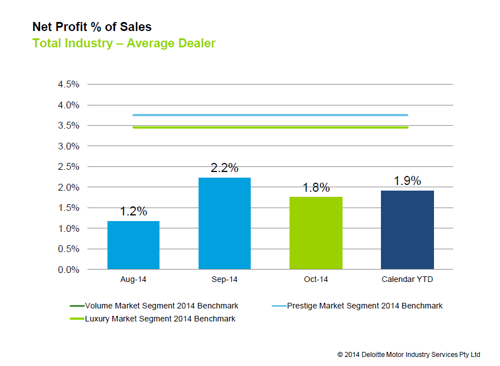
October 2014 Dealer Profitability
Deloitte Motor Industry Services | 1 November 2014
Total Industry
Dealer profitability as measured by net profit as a percentage of sales (NP%S) was 1.8% for the average Australian dealer in October 2014.
This result was below the calendar YTD NP%S level of 1.9% and also 0.3 percentage points down on the result of last month which benefited from quarterly new car incentive payments.
However, the October 2014 result was 0.3 percentage points above the October 2013 result last year furthering signs that the second half of 2014 will be more profitable than the second half of 2013.
State-by-State
New South Wales/Australian Capital Territory
The average NSW/ACT dealer NP%S was 1.8% in October which was 0.7 percentage points above the October 2013 result. This can be attributed to an improvement in gross margins across new and used vehicles and service. A particular strength exhibited by NSW/ACT this month was its performance in used vehicles with the average dealer earning $2,627 in gross per used vehicle retailed –$401 above the national average.
Queensland
With an NP%S of 1.9%, QLD was the most profitable state for the October month. This position was a result of the continued strong performance in finance & insurance (F&I). With a new finance penetration rate of 36% and generating $2,767 in new finance income per contract written, the average QLD dealer performed above the level of the national average.
South Australia/Northern Territory
Dealer profitability for the average SA/NT dealer was 1.7% in October with the state group continuing to be strong performers in new vehicles. The average dealer generated $2,884 gross per new vehicle sold (inclusive of aftermarket, holdback and incentives) which was $488 more than the average dealer across the country. This resulted in strong profitability at the department level with the average SA/NT dealer retaining 23% of the department’s gross profit once selling expenses (not including overheads) was taken away.
Victoria/Tasmania
VIC/TAS was one of two state groups where dealer profitability for the average dealer improved month-on-month with NP%S for October at 1.6%. VIC/TAS dealers outperformed the national average in parts operations this month, with gross margin for the department at the volume/prestige benchmark level of 24.0%. This was reflective of the contribution of ‘higher margin’ workshop parts sales to the total department sales mix. Workshop sales represented 31% of the total sales mix for the average VIC/TAS sales mix, compared to 25% of the national average.
Western Australia
NP%S for the average WA dealer was 1.5% in October which was a 0.5 percentage point improvement on the September result. Gross margins for the state were down in October with total dealership gross margin at 13.6% compared to the YTD figure of 15.1%. While the October figure is still above the national average, dealer profitability for the state continues to be impacted as the average dealer has a reduced gross profit pool from which to cover fixed expenses.
Segments
The luxury segment was the most profitable segment for the second month in a row, with a NP%S result of 2.1% in October. This also made it the only segment to have a NP%S result above its calendar YTD position.
The prestige segment was the next most profitable segment in October with a NP%S result of 1.8%, followed by the volume segment with a result of 1.6%. Both segments results in October were a 0.2 percentage point fall on the prior month.
Click the chart below for more information.
General Information Only
This presentation contains general information only, and none of Deloitte Touche Tohmatsu Limited, its member firms, or their related entities (collectively the “Deloitte Network”) is, by means of this presentation , rendering professional advice or services.
Before making any decision or taking any action that may affect your finances or your business, you should consult a qualified professional adviser. No entity in the Deloitte Network shall be responsible for any loss whatsoever sustained by any person who relies on this presentation.
About Deloitte
Deloitte refers to one or more of Deloitte Touche Tohmatsu Limited (“DTTL”), its global network of member firms, and their related entities (collectively, the “Deloitte organization”). DTTL (also referred to as “Deloitte Global”) and each of its member firms and related entities are legally separate and independent entities, which cannot obligate or bind each other in respect of third parties. DTTL and each DTTL member firm and related entity is liable only for its own acts and omissions, and not those of each other. DTTL does not provide services to clients. Please see www.deloitte.com/about to learn more.
Deloitte Asia Pacific Limited is a company limited by guarantee and a member firm of DTTL. Members of Deloitte Asia Pacific Limited and their related entities, each of which are separate and independent legal entities, provide services from more than 100 cities across the region, including Auckland, Bangkok, Beijing, Hanoi, Hong Kong, Jakarta, Kuala Lumpur, Manila, Melbourne, Osaka, Seoul, Shanghai, Singapore, Sydney, Taipei and Tokyo.
This communication contains general information only, and none of Deloitte Touche Tohmatsu Limited (“DTTL”), its global network of member firms or their related entities (collectively, the “Deloitte organization”) is, by means of this communication, rendering professional advice or services. Before making any decision or taking any action that may affect your finances or your business, you should consult a qualified professional adviser.
No representations, warranties or undertakings (express or implied) are given as to the accuracy or completeness of the information in this communication, and none of DTTL, its member firms, related entities, employees or agents shall be liable or responsible for any loss or damage whatsoever arising directly or indirectly in connection with any person relying on this communication. DTTL and each of its member firms, and their related entities, are legally separate and independent entities.


